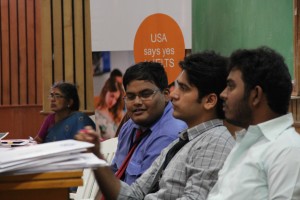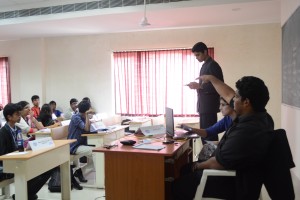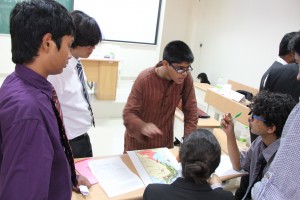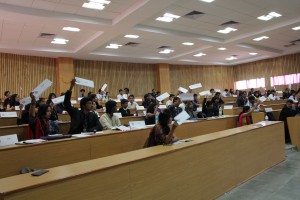Birla Institute of Technology and Science (BITS) Pilani is a name that is well known among high school and college students in India. BITS is not only a university; its a brand. In recent years, BITS Pilani opened three new campuses, at Goa, Hyderabad and Dubai. When the BITS name gets attached to the college, people expect big things out of you and Hyderabad campus is no exception.
Incidentally, BITS Pilani, the first of the three campuses, had just had its first ever MUN conference in 2007 and the first batch of students at Hyderabad were quick to pick up on this new activity. Model UN has always been very lucrative for students who take a keen interest in international relations and politics, and who like to debate about the same. In a country like India, it is not uncommon to have young adults keenly engrossed in the dynamics of national as well international political game play. Model UN, as it stands, provided the perfect platform for these students to understand and emulate actual UN representatives and they were quick to grab it.
The BITSMUN society at Hyderabad had its first tryst with MUN organization in 2010 when they helped organize BITSMUN Pilani in collaboration with the MUN society of the latter. This proved to be a very fruitful and learning experience in terms of understanding the intricacies that go into organizing a successful MUN. However, it left much to be wanted as very few students were directly involved and it wasn’t Hyderabad campus’ own conference to begin with. Moreover, first timers and other interested students hadn’t completely adapted to the rules and proceedings of these simulations and it left an air of anxiety and uncertainty about whether such an extracurricular was worth spending time on. The students that were involved with BITSMUN PIlani envisaged to put the experience that they had derived from the experience into creating a successful conference at the Hyderabad campus in the coming years. What played an important role in their plans was the fact that by the time things began coming up on the drawing table, for the first time, the campus had students in all 4 years, thus giving the maximum capacity of students to tap into. This was an added advantage because from 2007 to 2011, the number of MUNs in India literally went up exponentially and a number of students in all 4 batches had a little experience here or there.
Discussions began over possibilities in the future (sounds a lot like a Reuters report) and the first ever BITSMUN conference was scheduled to be held in October 2012. This was after several Mock MUNs within the college to give inexperienced students more exposure to the atmosphere within council and successfully at that. BITSMUN 2012 was a success in terms of organization as well as participation. 120 students turned up in 4 councils spread over 3 days. The Executive Board was very experienced and did an excellent job of mentoring as well as chairing over the various committees. Now came the important part. Running a successful conference once is a great thing but no herculean task.
What is, is carrying the same quality forward to the next conference and maybe, even outdoing yourself. In India, the concept of MUN has been trivialized by the fact that every Tom Dick and Harry college/school has its MUN and the very idea of Model UN has begin to blur with different institutions following different, and often incorrect rules of conduct. BITSMUN lived upto its hype in the South India circuit but so did many other MUNs in their very first simulations. However, due to the almost claustrophobic schedule of MUNs, attendances have come down and BITSMUN was next in the firing line. Preparations for BITSMUN 2013 began months in advance, with a lot of importance being laid on logistics. The previous year some issues had been faced regarding food, supply of water and a lack of personnel at the disposal of the Executive Board. Moreover, there were no sponsors the previous time and the society just about broke even. Obviously, in order to build a base for future conferences, it was essential to pull in a sponsor in order to cover costs as well as generate some extra money for next year. BITSMUN ’13 was scheduled for October 11-13th. This time around, we had Executive Board members with tons of experience and an additional unconventional committee, the Joint Crisis Cabinet. The expected number of delegates was twice the previous year and a lot more hard work was being put into making it a successful event. A lot of other colleges and high schools were expecting it to be a very grand event and probably one of the better simulations, considering the Executive Board that had applied and consequently been selected.
There were a total of 5 committees during this conference.

The members of the Executive Board of the UNGA contemplate on the point being made in committee by the respective delegate.
The United Nations General Assembly (DISEC) took up the question of of illicit Trade in Small Arms and Light Weapons with special focus on conventional ammunition. This was a rather interesting topic in a committee filled with first timers. The members of the Executive Board had taken this into consideration and attempted at making the experience a light and comfortable one, while at the same time conveying all the information they needed to participate in future MUNs. There was constant debate and often different sets of delegates would get into long, sometimes comedic arguing on different topics. Yet, in the end, every delegate was happy because everyone got a chance to participate.

The Chair of the UNHRC recognizes a point of information for the speech my the delegate on the dias.
The United Nations Human Rights Council was another first timer committee that deliberated on the issue of Human Rights in Cyber Space, what with all the recent public uproar over the same. This was a very energetic committee. Every delegate had a chance to speak and no delegate was left unquestioned. There were some experienced delegates in this committee and they had formed their own blocks to their advantage. The level of debating was decent and caucuses pertaining to certain issues had to be extended because there was so much discussion taking place.
The United Nations Emergency Response Committee was a futuristic committee based in the year 2020, revolving around the South China Sea issue. This was a smaller committee of barely 20 delegates. Delegates had been given a timeline of events leading up to 2020 and began debate from that point on. This was the first simulation of the UNERC in BITSMUN and it took a while for the delegates to adapt. However, by the second day, with guidance from the members of the Executive Board, the delegates were able to understand how to adapt to the new environment and come up with plausible explanations, theories and arguments. The crises that were introduced on the last two days were handled very well, as mentioned by the Chair in the closing ceremony.

The delegates of the JCC US-Vietnam War discuss their military strategies over the given map, while the Chair examines the same.
The Joint Crisis Cabinet was the unconventional committee and it was set in 1967 in the US-Vietnam War. An added element, emulated from LSEMUN, was that of military movements, juxtaposed with political deliberation. There were two cabinets – the US- South Vietnam cabinet and the North Vietnam cabinet. Over the 3 days, there was no paucity of debate and delegates were on their feet in a committee that worked on a perpetual crisis. Some delegates came up with some brilliant ideas that would have made the military generals and leaders of the 60s and 70s proud. At the end of committee, they were able to change history and US and South Vietnam managed to enter into North Vietnam, with repercussions of the same felt in China and Russia. It was a successful simulation in terms of participation and understanding how an unconventional committee works.
The United Nations Security Council convened with the 12 member states and 9 observer nations. There were two topics on their agenda – Peace Consolidation in West Africa and the Possibility of an Arctic Treaty. There were some very experienced delegates in the UNSC and right from the get go, the delegates began dissecting each issue. The members of the Executive Board chose to keep fewer un-moderated caucuses due to the fact that two issues had to be discussed in the given time span. In the end, the committee successfully discussed the issues at hand.
The closing ceremony was testament to how successful the conference really was, as delegates broke into a dance before the closing ceremony when one of the organizers accidentally played music on the stage. Awards were given and delegates were acknowledged and the members of the Executive Board as well as some of the participants thanked BITSMUN Society for the conference and promised to come again the year after. The success that was achieved in BITSMUN Hyderabad 2013 was unprecedented and delegates now are waiting for the next simulation at BITS Hyderabad.


